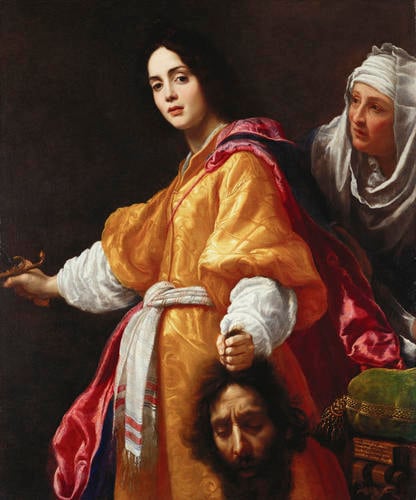-
1 of 253523 objects
Judith with the Head of Holofernes Signed and dated 1613
Oil on canvas | 120.4 x 100.3 cm (support, canvas/panel/stretcher external) | RCIN 404989
-
Judith was a beautiful Jewish widow, who entered the tent of the Assyrian general Holofernes, decapitated him with his own sword, and brought his head back to her people. According to his biographer Baldinucci, Allori painted this work in part as an autobiographical account of his love affair with Maria de Giovanni Mazzafirri, which ended badly. The figure of Judith, Baldinucci claimed, resembles ‘La Mazzafirra’, the servant in the background her mother, and the severed head of Holofernes is a portrait of the artist himself.
The inclusion of the inscription in the lower right hand corner of the painting hints at the self-referential nature of the work. When the poet Giovanni Battista Marino saw a version of this painting in Paris, he specifically read the work as autobiographical, commenting that Holofernes is killed twice, first by the darts of Cupid and second by the sword of Judith. Allori was by no means unique amongst his artistic contemporaries in his desire to make the story relevant to his own experience and the picture belongs to a tradition in which artists included portraits within apocryphal narratives.
This subject became one of Allori’s best-known compositions, as the existence of numerous versions of the subject by the artist and his workshop attests. This is an especially fine early rendering; the realistic, intensely particularized features of Judith are coarser than in other versions, suggesting that it is a credible portrait of the artist's persecutor. Even though carefully executed preparatory drawings have been identified for this work, Allori seems to have made numerous small adjustments to the composition while painting. Later versions of the same subject, including that of 1620 in the Pitti Palace, are more firmly executed and lack the vibrancy and painterly qualities of this one.
The work is characteristic of Allori’s use of rich colours and his sophisticated rendering of texture and form. The carefully conceived composition and the dramatically positioned head of Holofernes, which seems about to emerge into the space of the beholder, add to the emotional intensity of the painting and clearly indicate why this influential work became emblematic of Florentine Baroque painting for centuries thereafter.
Inscribed at the end of the bed in lower right: Hoc Cristofori Allorii/Bronzinii opere natura/hactenus invicta pene/vincitur Anno 1613Provenance
Acquired by Charles I, probably from the Gonzaga collection, Mantua; recorded by Abraham van der Doort in 1639 in the Gallery, St James's Palace (no 9); sold for £60 to George Greene and others on 23 October 1651 from St James's (no 227); perhaps the unattributed picture of this subject returned by Lord Lisle after the Restoration; listed in the Long Matted Gallery at Whitehall in 1666 (no 6)
-
Creator(s)
Acquirer(s)
-
Medium and techniques
Oil on canvas
Measurements
120.4 x 100.3 cm (support, canvas/panel/stretcher external)
133.0 x 111.2 x 4.5 cm (frame, external)
Other number(s)
Alternative title(s)
Judith
